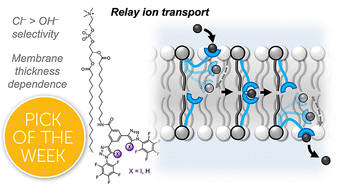Halogen bonding relay and mobile anion transporters with kinetically controlled chloride selectivity†
Abstract
Selective transmembrane transport of chloride over competing proton or hydroxide transport is key for the therapeutic application of anionophores, but remains a significant challenge. Current approaches rely on enhancing chloride anion encapsulation within synthetic anionophores. Here we report the first example of a halogen bonding ion relay in which transport is facilitated by the exchange of ions between lipid-anchored receptors on opposite sides of the membrane. The system exhibits non-protonophoric chloride selectivity, uniquely arising from the lower kinetic barrier to chloride exchange between transporters within the membrane, compared to hydroxide, with selectivity maintained across membranes with different hydrophobic thicknesses. In contrast, we demonstrate that for a range of mobile carriers with known high chloride over hydroxide/proton selectivity, the discrimination is strongly dependent on membrane thickness. These results demonstrate that the selectivity of non-protonophoric mobile carriers does not arise from ion binding discrimination at the interface, but rather through a kinetic bias in transport rates, arising from differing membrane translocation rates of the anion–transporter complexes.

- This article is part of the themed collections: 2023 Chemical Science HOT Article Collection, #MyFirstChemSci 2023 and 2023 ChemSci Pick of the Week Collection


 Please wait while we load your content...
Please wait while we load your content...